
Stourhead is a 2,650-acre estate at the source of the River Stour in the southwest of the English county of Wiltshire, extending into Somerset and includes a Grade I listed 18th-century Neo-Palladian mansion, the village of Stourton, one of the most famous gardens in the English landscape garden style, farmland, and woodland. Stourhead has been part-owned by the National Trust since 1946. I visited Stourhead on my first day in Wiltshire back in May and it marks the beginning of my romance with the county.
I arrived at Stourhead under a vale of rain with my usual companion in tow. We had unfortunately timed our visit to coincide with a marathon that was happening across the estate and so, as we walked through a small wood and up into the walled gardens, we had to wind our way through clusters of drenched runners and their supportive but damp families. Despite the rain we couldn't help but stop and admire the wisteria and the tumbling yellow roses. The finish line was in front of the house and as we rushed passed under the shelter of our umbrellas, making a beeline for the shelter of the house, the clock told us that they had been running for eight hours. With this sea of soaked people at its doorstep, a country house has never looked so inviting.
With the urgent focus of finding shelter now passed, we were able to stop and look around, we found ourselves in the Entrance Hall. The doors first grabbed ones attention for they were encased in elaborate pillars and pediments. The walls were a rich red and were covered in family portraits whose gilded frames glinted in the the dim light, caught by the lamps that were balanced on the heads of panthers. A set of four upholstered coffee tables on the checkered marble floor were lined up in front of the ornate fireplace, which framed a portrait of what seemed to be father and son, the father froze in the process of rolling up a print.
Taking the first door on the left and we had entered the Music Room. This room was also painted red and covered with ornately framed paintings (a theme that would recur throughout the house) but these paintings were not formal portraits, there were mythical scenes and landscapes with the focus on the painting that was exquisitely framed into the mantelpiece. The room was nearly empty but for a few small bookcases, various chairs, a small piano tucked by the door and a Steinway piano kept company by a music stand.
Through a red ante room and we were in my favourite room in every house, the Library. The room was painted a cool green, bookcases lined the walls and even in the dim light, a series of stained glass windows were lit under the lattice ceiling. It was a grand room, added by a family member of the house in the 1790s. Sir Richard Colt Hoare was passionate about writing, traveling, art, archaeology, and the study of antiquities. His passions were reflected in the design of the room, with its Greek and Egyptian motifs as well as the many books that sat on the shelves. There are few more beautiful sights than rows upon rows of old gilded books.
Back through the Music Room and we were in what was called the Little Dining Room. Here the walls were once again painted red but this time in a much more softer hue. A small table with four chairs sat in the centre of the room and one end of the room were three large windows and I was surprised when I looked out of them to find a man juggling in the rain. I don’t know what must happen in a mans life to make him juggle in the rain on the lawn of a stately home but I prefer to believe that it was out of determination to learn than out of depression. The opposite end of the room had been separated by Corinthian columns where oval paintings framing a bronze bust of a man with an excellent moustache and a grandfather clock ticked softly away in the corner.
Through a door and we were in the Inner Hall. The walls were a soft green and two flights of white stairs rose out of the marble floor. More clocks softly ticked and while we were not permitted to go upstairs, glimpses of large mythological paintings could be seen on the first floor including a woman being given a mans head on platter. A garland covered in flowers had been draped along the balusters of the stairs in a hopeful but so far unfulfilled announcement of spring.
From the hall we were only able to look into the Saloon. The walls were covered in a dark red brocade, antiquities were placed on the sideboards, paintings from various periods hung on the walls and a chess set abandoned mid game waited in vain for its players to return.
The next room was the Column Room, so called for at the time of Horace Walpole's visit to Stourhead in 1762 this was the 'bedchamber with columns'. In Sir Richard Colt Hoare's time this room became a temple to the watercolour, and it is still hung today with views of Rome and the surrounding countryside by the Swiss artist Abraham-Louis Ducros. The room was painted in a soft sand colour and a large cabinet containing books of medieval texts lay open inside.
This was followed by the Italian Room, painted in a mix of white and powder blue, a small alcove was the feature of the room, whose original purpose was once to enclose a bed. Three damask chairs sat at a mahogany table carved with the image of Dionysus and banners of grapes, three glasses and an empty decanter waited for a party that would never come.
Through another door and we were in a scarlet painted room know as the Cabinet Room. Once Stourhead's Library, it now held the Pope's Cabinet, brought to the house by Henry Hoare II in 1741, and is name thus because it is thought to have belonged to a Pope.
Through a corridor painted in yet more red and we found ourselves in the Picture Gallery. Built at the same time as the Library, this large room was the crowning jewel of the house. The walls were in green and a sparkling chandelier hung at its centre. Out of all the paintings in the Gallery, one in particular caught my attention, the Shipwrecked Marine from James Thomson's poem The Seasons:
Sad on the jutting eminence he sits,
Ships, dim-discovered, dropping from the clouds;
And views the main that ever toils below;
At evening, to the setting sun he turns
Still fondly forming in the farthest verge,
A mournful eye, and down his dying heart
Sinks helpless.
Retracing our steps back through the Cabinet Room and into the Entrance Hall. We looked out through the windows to find the rain had become even heavier so there was nothing else to do but grab our umbrellas and make a run for my favourite part of every National Trust property. The Bookshop. No treasure was to be found that day and even worse, the pub was full. At the recommendation of our host we came back to look at the famous gardens in the evening and as she promised, we had the entire place to ourselves. So we sat on a bench in the churchyard underneath a rhododendron and watched the sun set over the lake and all of it's follies and temples.



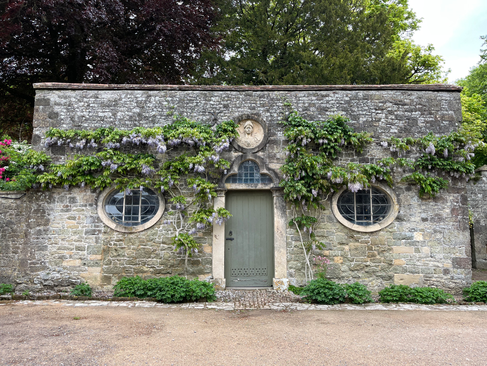







































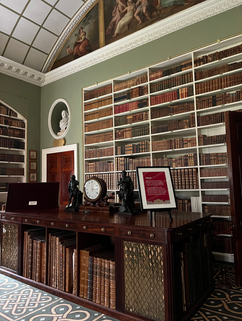



























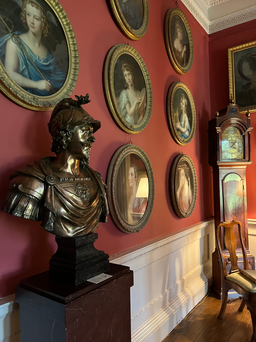

























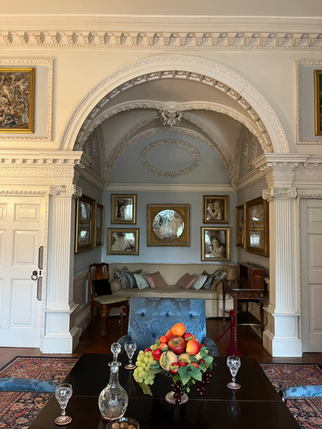



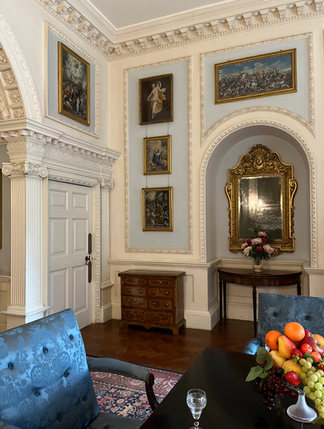



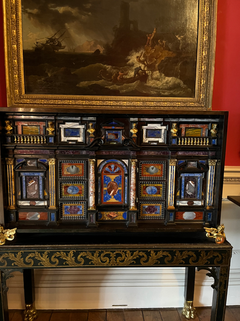













































































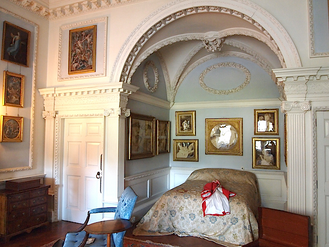












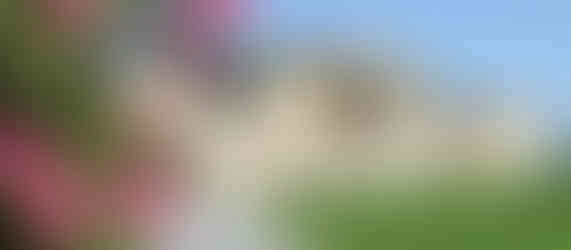


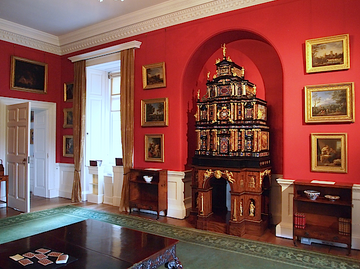











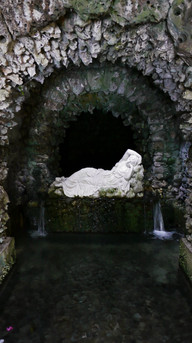

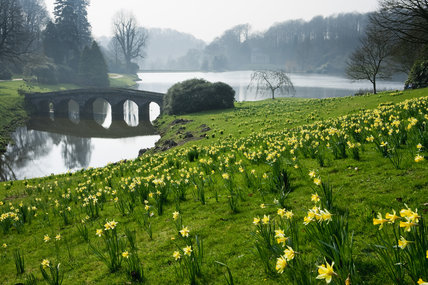


















































Comments